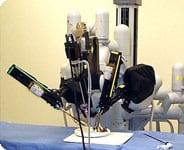Da Vinci Robot Surgery Injury Lawyers
Saiontz & Kirk is no longer accepting new clients for da Vinci Robot Surgery Lawsuits
The contents of this page are provided for informational purposes only
As of May 2015, the injury lawyers at Saiontz & Kirk, P.A, are no longer reviewing potential product liability lawsuits for individuals throughout the United States who have experienced serious and potentially life-threatening complications after da Vinci robotic surgery.
Many individuals have pursued a da Vinci robot lawsuit as a result of alleged defects with the design of the surgical system, as well as the manufacturer’s failure to provide sufficient instructions and failure to adequately warn about the risk of a daVinci robot injury. New cases are no longer being accepted by the law firm of Saiontz & Kirk, P.A., and this page is provided for informational purposes only.
DA VINCI SURGICAL SYSTEM INJURY RISKS
The da Vinci Surgical System is a complex robot manufactured by Intuitive Surgical, Inc. which is used in a number of different surgical fields, including:
- Cardiothoracic
- Gynecology
- Urology
- General Surgery.
As a result of minimal training provided to some physicians and problems with the design of the daVinci surgical robot, individuals may face an increased risk of surgical complications that could have been avoided if other safer methods had been used.
In addition to mistakes caused by inexperienced surgeons, da Vinci surgery complications may arise from the device’s use of monopolar energy to cut, burn and cauterize tissue. The da Vinci robot also appears to have defective and inadequate insulation for the arms.
These design problems may allow the electrical current from the da Vinci robot to pass outside of the operative field, causing damage to surrounding organs, vessels or tissue, such as:
- Ureters
- Arteries
- Blood Vessels
- Bowel
- Bladder
- Vaginal Cuff
- Other Organs or Tissue
A da Vinci surgical injury may occur without the surgeon even being aware of the complications. As a result, many patients have been discharged home following a da Vinci robotic-assisted surgery, only to discover the injury days later, requiring return hospitalization, additional surgery and even resulting in death in some cases.
The manufacturer of the device, Intuitive Surgical, failed to perform or sponsor sufficient testing to to determine whether da Vinci robotic surgery is any more safer or more effective than other surgical and laparoscopic methods, according to allegations raised in lawsuits filed in courts throughout the country. The manufacturer also failed to adequately examine the long-term outcomes and appears to have minimized or withheld information about the true extent of complications and injuries following da Vinci surgery.
DA VINCI ROBOT INJURY LAWSUIT
Da Vinci robotic-assisted surgery may pose serious and devastating risks for patients, which could have been avoided if a safer alternative design had been used, additional warnings and information had been provided for consumers or if surgeons had been adequately trained on use of the complex robot.
The lawyers at Saiontz & Kirk, P.A. are no longer reviewing daVinci robotic injury lawsuits for individuals throughout the United States who have experienced complications. Prior claims were investigated for individuals who experienced any of the following problems or complications following surgery:
- Burns
- Tears
- Dehincenses or ruptures of organs that allow contents to leak out
- Hematomas or Internal Bleeding
- Fistulas or abnormal connections created between organs or vessels
- Sepsis or Infections following robotic surgery
- Emergency surgery to correct issues that arise during daVinci surgery
All da Vinci robotic surgery lawsuits were pursued under a contingency fee agreement, which means that there are no attorney fees paid unless we are successful obtaining a recovery and there are no out-of-pocket costs associated with investigating a case.
Top Photo via http://en.wikipedia.org/wiki/User:Nimur / CC by 3.0

